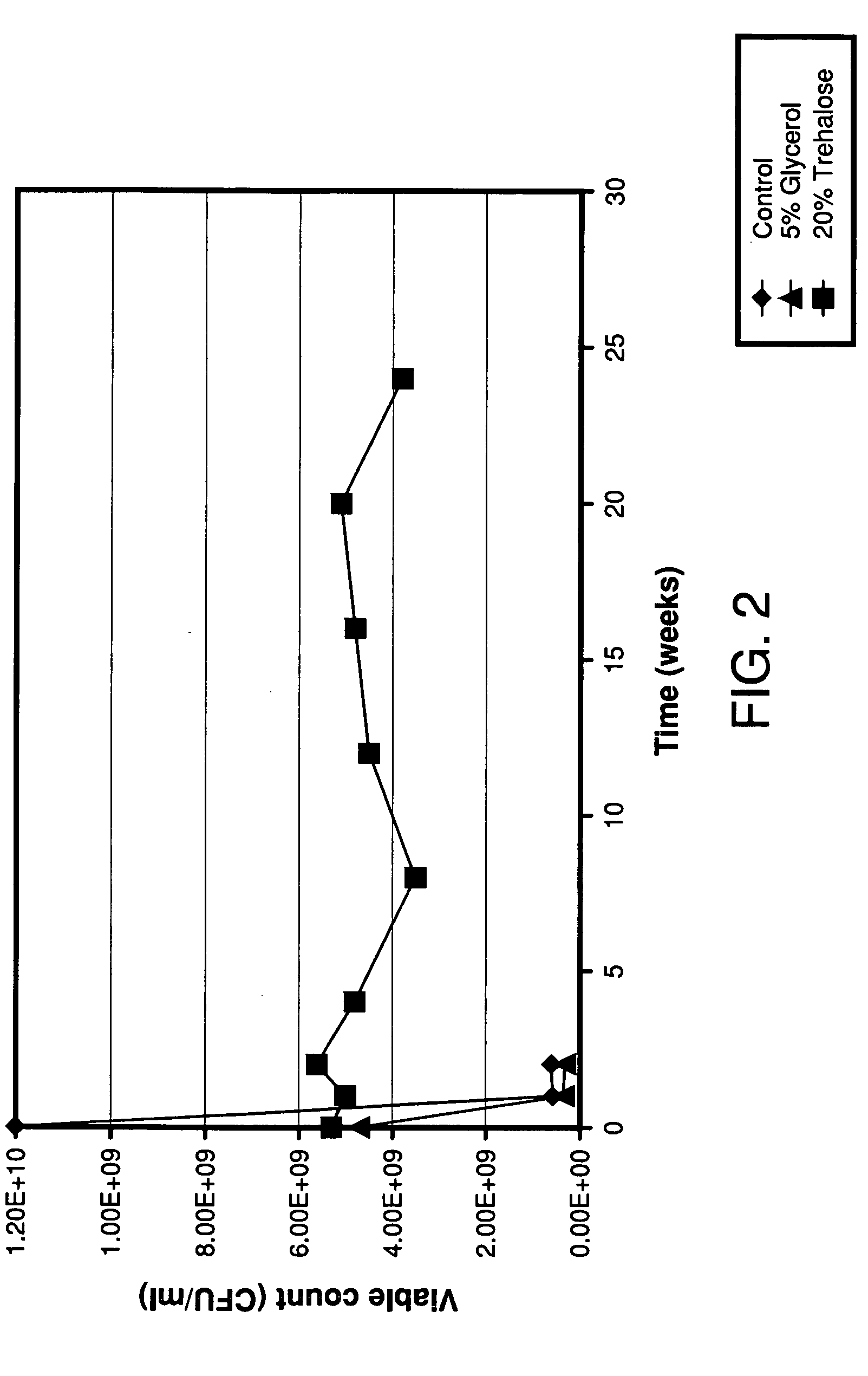Shelf life and on seed stabilization of liquid bacterium inoculants
- Summary
- Abstract
- Description
- Claims
- Application Information
AI Technical Summary
Benefits of technology
Problems solved by technology
Method used
Image
Examples
example 2
Optimization of the Level of Trehalose / Sucrose Required to Stabilize B japonicum
[0076] The procedure followed for the preparation of the flasks was the same as in Example 1. The treatments for this example are given in Table 4.
TABLE 4Treatments - Influence of trehalose andsucrose on stability of B japonicumTreatmentWater(g)Trehalose(g)Sucrose(g)Control5000 5% trehalose455010% trehalose4010020% trehalose3020030% trehalose2030040% trehalose10400 5% sucrose450510% sucrose4001020% sucrose3002030% sucrose20030
[0077] The results of the treatments with regard to the survival of B japonicum incubated in a liquid broth at 28° C. are shown in FIG. 4. The results of the treatments with regard to the survival of B japonicum incubated in a liquid broth at 35° C. are shown in FIG. 5.
[0078] The results shown in FIG. 4 indicate that at 28° C., treatments with trehalose concentrations between 10% and 30% weight / volume are optimal for survival of the bacteria in the liquid broth. FIG. 4 also indi...
example 3
Evaluation of Stability of Serratia proteomaculans and Pseudomonas fluorescens in Liquid Broth Formulation
[0082]Serratia proteomaculans (“S proteomaculans”) was cultured in a standard microbiological medium (half strength Tryptic soya broth—“TSB”) for 24 hours at 22° C. to create a bacterial broth. A set of flasks was prepared, with each flask in the set corresponding to one of the treatments listed in Table 5. 50 ml of the bacterial broth was added to each of the flasks. All the flasks were allowed to equilibrate for an additional 3 days in a shaking incubator at 22° C. The flasks were then transferred to static incubation at 28° C. Periodically samples were taken and bacterial numbers were assessed by preparing serial dilutions and plating onto a half strength Tryptic soya agar—“TSA”.
[0083] The same steps were repeated for Pseudomonas fluorescens (“P fluorescens”).
TABLE 5Treatments - Influence of trehalose, sucrose, and glycerolon stability of S proteomaculans and P fluoresce...
example 4
Effect of Low Volume Application Rate on “On-Seed” Survival Plus a Comparison with a Commercial Product
[0086] A partially desiccated inoculant product was prepared according to Example 1. The product included B japonicum, 20% trehalose, and 2% S-630. The product was stored in 500 ml bladders without air for four months at 5° C. before being applied to seeds.
[0087] The partially desiccated product was applied to soybean seeds (12% moisture). The seeds were treated with a total volume (partially desiccated inoculant product plus water) of 4 fluid ounces per 100 pounds of seed. The treatment was prepared by using various volumes of concentrate (1 to 4 fluid ounces per 100 pounds of seed) mixed with the appropriate amount of water to bring the total volume up to 4 fluid ounces per 100 pounds of seed. Once treated, the seeds were shaken in a bag to ensure even coverage. The bag was left open and the seeds were stored at ambient temperature (18° C. to 20° C.).
[0088] Seeds were also tre...
PUM
 Login to View More
Login to View More Abstract
Description
Claims
Application Information
 Login to View More
Login to View More - R&D
- Intellectual Property
- Life Sciences
- Materials
- Tech Scout
- Unparalleled Data Quality
- Higher Quality Content
- 60% Fewer Hallucinations
Browse by: Latest US Patents, China's latest patents, Technical Efficacy Thesaurus, Application Domain, Technology Topic, Popular Technical Reports.
© 2025 PatSnap. All rights reserved.Legal|Privacy policy|Modern Slavery Act Transparency Statement|Sitemap|About US| Contact US: help@patsnap.com



